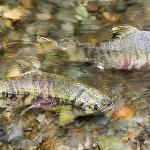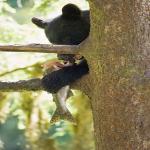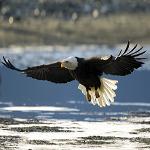08 July 2010

Photo: Amy Gulick/amygulick.com
Chum salmon (onorhynchus keta) on a spawning run in a Tongass stream
The Tongass rainforest in the far northwestern U.S. state of Alaska is one of the rarest ecosystems on earth. Salmon play a critical role for people and wildlife in this unusual coastal forest.
Photographer Amy Gulick says she always thought of rainforests as being in the tropics – places like Brazil and Indonesia. Then she found out about the Tongass.
"This is a very, very rare ecosystem," says Gulick. "It's called a coastal temperate rainforest. This type of ecosystem has only ever existed on one thousandth of the earth's land surface. It takes just the right conditions for this type of ecosystem to form."

Amy Gulick/amygulick.com
The Tongass includes the more than 5,000 islands of the Alexander ArchipelagoThe Tongass rainforest stretches in a narrow band along southeastern Alaska's Pacific Ocean coastline. Covering almost 68,000 square kilometers, the Tongass is by far the largest national forest in the United States.
Gulick spent months in the Tongass, photographing its wildlife and people for her new book, called Salmon in the Trees. More about that title later.
Wildlife thrives in the Tongass rainforest
The Tongass contains nearly a third of the world's remaining old growth coastal temperate rainforest. Other areas remain along the coasts of Chile and New Zealand, with smaller patches in Tasmania, Norway, and Japan.

Amy Gulick/amygulick.com
A Black Bear snacks on salmon in a tree at Tongass National Forest in Alaska.Like the rainforests of the tropics, Alaska's coastal rainforest teems with wildlife.
"Every species that has existed here since the time of European settlement in the 1700s is still here," Gulick says. "Nothing is missing. So animals like wolves, grizzly bears, bald eagles, millions of wild salmon, humpback whales, steller sea lions thrive here again as they have for, for thousands of years."
Included with Gulick's book is a CD of wildlife sounds produced by anthropologist and writer Richard Nelson.
Salmon support the forest ecosystem
The Tongass, says Gulick, is a giant mosaic of different landscapes. Only about 60 percent of the Tongass is actually forested. The rest is rock, ice, wetlands and water - more than 20,000 lakes and ponds, and 64,000 kilometers of streams. Much of the forest is spread out over 5,000 coastal islands.
"And because of all those islands, no point on land is far from the sea," Gulick explains. "So this is very much a place where the forest and the sea are interconnected. And again the salmon link the land to the sea."
Salmon play a central role in the Tongass ecosystem. Every year, adult salmon return from the Pacific Ocean to the freshwater streams where they were born, to lay their eggs, and die. The migrating fish fill the waterways of the forest.

Amy Gulick/amygulick.com
Thousands of pairs of bald eagles nest in the Tongass"There are times," says Gulick, "when I was standing on salmon streams that you could literally walk across the stream on the backs of these fish."
Such a high concentration of fish attracts over 50 species of birds and other animals, eager to take advantage of the feast.
"It's this glorious show. When the salmon enter the forest, the whole place comes alive. There are bears everywhere, eagles cawing, ravens are screeching, and again it's just this vibrant show of life going on all around you, it's a very, it's a very exciting time."
Bears often carry their catch back among the trees to eat, leaving thousands of fish carcasses scattered throughout the forest. Over time, these remains decompose, releasing nutrients into the soil where trees can take them up again.
Gulick says researchers have found evidence of salmon in the trees: "Scientists have actually been able to trace a particular form of marine nitrogen in trees near salmon streams that they can link back to the fish."
Salmon are also critical to the 70,000 people who inhabit the Tongass: coastal waters support a thriving commercial fishery, and wildlife tourism is flourishing.
Protecting the trees to save the forest
But, Gulick notes, not all development has been friendly to the fish and the forest ecosystem that supports them. "Industrial-scale logging began pretty heavily in the 1940s and 50s, and continued pretty heavily for about 50 years."
Gulick says public outcry against the logging industry slowed the cutting of the centuries-old trees of the old growth forest. Environmental groups continue to lobby to preserve the most biologically productive areas of the Tongass.
"By protecting these key areas, the best salmon producing areas, the best places for bears, the best places for deer, best places for bald eagles, then that should preserve the ecological integrity of the whole area."
Amy Gulick visited and photographed some of those "best places" in the Tongass National Forest, while working on her recent book, Salmon in the Trees.
Meanwhile, in a move hailed by environmentalists, the U.S. Forest Service recently announced it was changing its policy in the Tongass, shifting logging operations away from old-growth forest to areas that have previously been harvested. The policy change should help ensure that Alaska's rare Tongass rainforest will be around for future generations of salmon, bears and people to enjoy.